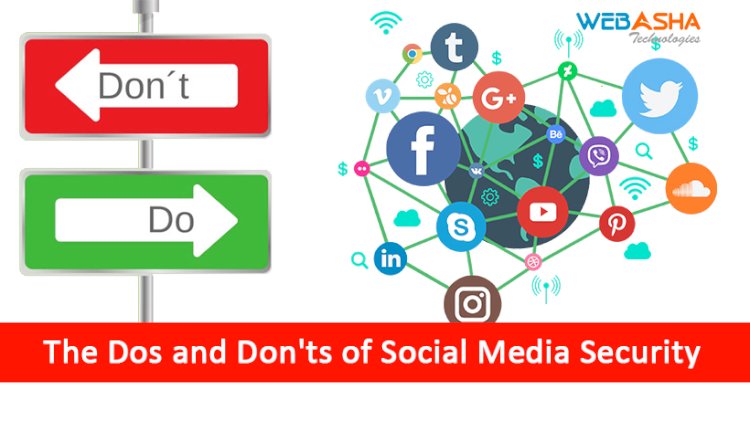The Dos and Don'ts of Social Media Security: A User's Guide
Enhance your social media security with our comprehensive guide on the dos and don'ts of safeguarding your online presence. Learn about strong passwords, two-factor authentication, privacy settings, and more.

In the digital age, social media has revolutionized the way we connect, share, and communicate. From keeping up with friends and family to promoting businesses and building communities, social platforms have become an integral part of our lives. However, with this increased connectivity comes the critical responsibility of safeguarding our personal information and maintaining our online security. In this comprehensive guide, we will explore the essential dos and don'ts of social media security to help you navigate the virtual landscape securely and confidently.
The Dos:
1. Use Strong and Unique Passwords:
Do create strong and unique passwords for each of your social media accounts. A strong password consists of a combination of upper and lowercase letters, numbers, and symbols. Avoid using easily guessable information like birthdays or names.
2. Enable Two-Factor Authentication (2FA):
Do take advantage of two-factor authentication whenever possible. This adds an extra layer of security by requiring a second verification step beyond your password, such as a unique code sent to your phone. Even if a hacker manages to obtain your password, they won't be able to access your account without the second factor.
3. Be Wary of Phishing Attempts:
Do exercise caution when receiving unsolicited messages or emails that ask for your login credentials. Phishing is a common tactic used by cybercriminals to trick users into revealing sensitive information. Verify the authenticity of the message and sender before clicking on any links or sharing personal details.
4. Keep Your Apps and Devices Updated:
Do regularly update the apps you use to access social media platforms and the devices you use to access those apps. Developers release updates to fix security vulnerabilities, and by keeping your software up to date, you can protect yourself from potential attacks.
5. Review and Adjust Privacy Settings:
Do take the time to review and adjust the privacy settings of your social media accounts. Platforms often provide granular control over who can see your posts, tag you, or access your personal information. Regularly assess and update these settings to align with your comfort level.
6. Educate Yourself:
Do stay informed about the latest security threats and best practices. Cybercriminals constantly evolve their tactics, so ongoing education is essential. Follow reputable cybersecurity blogs, official platform updates, and news sources to stay up-to-date on potential risks.
7. Limit Oversharing:
Do exercise restraint when sharing personal information online. Avoid oversharing details like your home address, phone number, or travel plans. Cybercriminals can exploit this information for identity theft or targeted attacks.
The Don'ts:
1. Don't Use Weak Passwords:
Don't use easily guessable passwords such as "password123" or "qwerty." Additionally, avoid using the same password across multiple accounts. A breach in one account could lead to compromised access to others.
2. Don't Trust Unknown Links and Attachments:
Don't click on links or open attachments from unknown or suspicious sources. Cybercriminals often use these tactics to distribute malware or trick users into revealing their login credentials.
3. Don't Overshare Personal Details:
Don't provide unnecessary personal information on your social media profiles. Details like your full birthday, home address, and phone number can be exploited by malicious actors. Share only what is necessary and relevant.
4. Avoid Using Public Wi-Fi for Sensitive Activities:
Don't access your social media accounts or conduct sensitive transactions while connected to public Wi-Fi networks. Public networks can be less secure, making it easier for hackers to intercept your data.
5. Don't Accept Friend Requests from Strangers:
Don't accept friend requests or connection requests from individuals you don't know. Cybercriminals often create fake profiles to gather information or launch attacks.
6. Don't Share Passwords:
Don't share your social media passwords with anyone, even with close friends or family members. Keeping your passwords confidential is essential for maintaining the security of your accounts.
7. Avoid Using Third-Party Apps Without Research:
Don't grant access to third-party apps without thoroughly researching their credibility and permissions. Some apps may request excessive access to your account, potentially compromising your security.
Conclusion:
Securing your social media presence is a paramount concern in today's digital landscape. By following the dos and don'ts outlined in this guide, you can significantly enhance your social media security posture. Remember, online security is an ongoing process that requires vigilance and a proactive approach. As technology evolves, so do the tactics of cybercriminals. By staying informed, practicing good security habits, and utilizing the tools provided by social media platforms, you can enjoy a safer and more secure online experience.














![Top 10 Ethical Hackers in the World [2025]](https://www.webasha.com/blog/uploads/images/202408/image_100x75_66c2f983c207b.webp)








